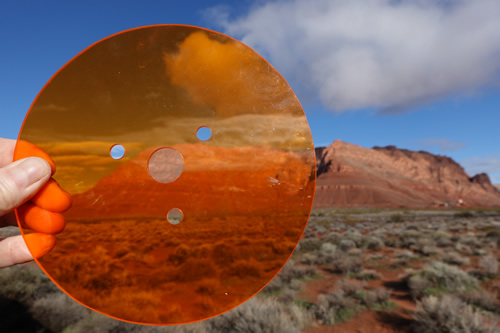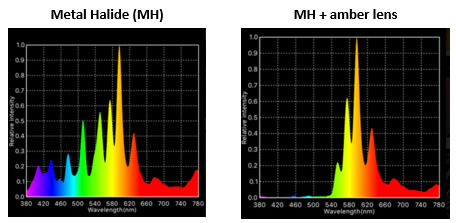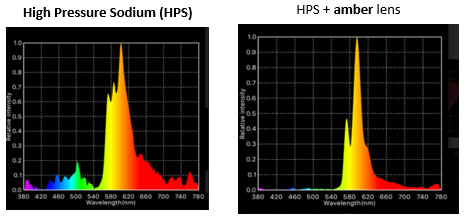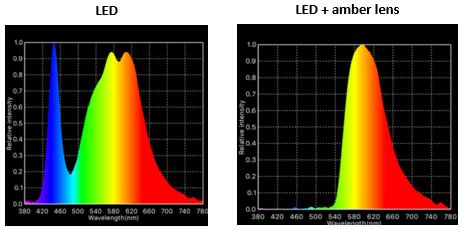The City recently installed some outdoor LED lighting with a color temperature of 3,000k. That meets the minimum requirement of the International Dark Sky Association (IDA), but it is still a pretty bright white light compared to High Pressure Sodium lighting, because of the amount of blue light generated.
We talked about the problems blue light creates in earlier blog posts. So the City took an extra step by putting an amber lens over the LED. (see our March 5th post, “Changing Light With an Amber Lens.”

The lens creates a warmer yellow to orange light, essentially turning the LED into a “filtered” LED (FLED).
We wanted to see how effective the amber lens is at reducing blue light. That’s the part of the light spectrum that creates problems. So, Nathan Dupre and Paul Andrews spent a few nights collecting, among other things, the color temperature of lights around Ivins, with and without the amber lens. Then Nathan downloaded the results and analyzed them. Here’s a look at some of his findings.
The charts below show that the amber lens almost completely eliminates the blue portion of the spectrum and most of the green as well for all types of lighting. Eliminating blue goes a long way towards reducing glare and creates a warmer, healthier, more comfortable light.


High Pressure Sodium (HPS) lights have very little blue in their spectrum, even without the amber lens. The color temperature of the HPS lights Nathan measured were around 1,800k. Adding the amber lens didn’t do much, because there is so little blue in the spectrum anyway. For example, one light he tested dropped from 1,800k to 1,630k when the amber lens was used.
This warm light has been a common outdoor lighting source for decades. But because they are much less energy efficient than LEDs, they are gradually being phased out all around the country. The result is that the warm outdoor lighting we have been used to seeing for decades is being replaced by colder, whiter LEDs that create all kinds of problems.

Although LEDs are much more energy efficient, that benefit comes at a cost. They pump out a lot of blue light. Lower color temperatures generate less blue, but all “untreated” LEDs produce blue light. The LED in the chart above has a color temperature of close to 4,000k. When you add the amber lens the temperature drops to just 1,800k.
The addition of the amber lens creates a warmer light with less glare and virtually eliminates harmful blue light. That sounds terrific, so what’s the catch?
An Illuminating Study
In addition to measuring the color temperature of city lighting, Nathan also measured the illumination of the lights, with and without the amber lens. He found that adding the lens to High Pressure Sodium lights did not reduce illumination very much because this light doesn’t have much blue in its spectrum to begin with. So although the amber lens does not reduce illumination very much, there’s really no added value from using the lens because there’s not much blue light to deal with.
But LEDs are a different matter. They have a lot of blue light which the amber lens eliminates. The lens we were using also eliminates a lot of the green portion of the spectrum. The result is the amber lens cuts illumination almost in half.
Using a lens to modify the color temperature of LEDs and reduce blue light is a good solution and a worthy goal. We’ve just started to research the illumination issue, but it appears it is possible to filter the LED to achieve that goal but maintain 80% to 90% of the illumination. That would be ideal.
We plan to run some tests on possible solutions in the next week and will let you know what we find. Nathan’s research turned up some other important information. We will share these issues later this week in another posting.
Join us
We have lot more research planned, so if you would like to join our Technical Committee we would appreciate the extra brainpower. Just send us an email from the Contact Us page.
